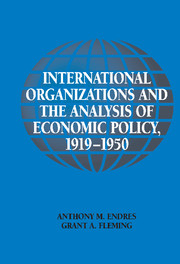Book contents
- Frontmatter
- Contents
- List of Figures and Tables
- List of Abbreviations
- Preface
- 1 Economics and Policy in International Organizations: Introduction
- 2 Business Cycles: Conceptions, Causes, and Implications
- 3 The Role and Conduct of Monetary Policy in the 1920s and 1930s
- 4 Public Investment Programs in the Interwar Period: Pre-Keynesian, Proto-Keynesian, and Keynesian Perspectives
- 5 Trade Policy Research: Geneva Doctrine and the Scandinavian Connection
- 6 Social Economics at the ILO: Scope, Content, and Significance
- 7 International Finance and Exchange Rate Policy
- 8 The Full Employment Movement from the 1940s
- 9 Conclusion
- References
- Index
6 - Social Economics at the ILO: Scope, Content, and Significance
Published online by Cambridge University Press: 29 July 2009
- Frontmatter
- Contents
- List of Figures and Tables
- List of Abbreviations
- Preface
- 1 Economics and Policy in International Organizations: Introduction
- 2 Business Cycles: Conceptions, Causes, and Implications
- 3 The Role and Conduct of Monetary Policy in the 1920s and 1930s
- 4 Public Investment Programs in the Interwar Period: Pre-Keynesian, Proto-Keynesian, and Keynesian Perspectives
- 5 Trade Policy Research: Geneva Doctrine and the Scandinavian Connection
- 6 Social Economics at the ILO: Scope, Content, and Significance
- 7 International Finance and Exchange Rate Policy
- 8 The Full Employment Movement from the 1940s
- 9 Conclusion
- References
- Index
Summary
INTRODUCTION
The ILO constitution of 1919 enshrined the achievement of “social justice” as a core general objective of the organization. Following that broad objective, the International Labour Office proceeded to the specific task of investigating “every question appertaining to conditions of labor” (Thomas 1921a: 10–11). Studying “conditions of labor” requires a wide purview, encapsulating all the areas of research only later to be known as “social economics” (Clark 1936). Areas of study included working conditions and remuneration, population, health, housing, social services and pension schemes, unemployment insurance, and relief schemes and education. Later, one contribution to the Cambridge Economic Handbook Series succinctly outlined the social economist's modus operandi:
to apply economic theory to social problems;
to measure, where possible, the extent of social problems;
to study the social causes of economic behavior; and
to study the social consequences of economic behavior (Hagenbuch 1958:2).
In all these respects, ILO researchers acted as social economists; the scope and method of their work was far from being narrowly confined by the conventional boundaries of contemporary economic theory. ILO social economists made generous allowances for “noneconomic,” social, or institutional aspects of human behavior. Often these factors rendered irrelevant or inapplicable much received microeconomic economic theory.
- Type
- Chapter
- Information
- Publisher: Cambridge University PressPrint publication year: 2002

